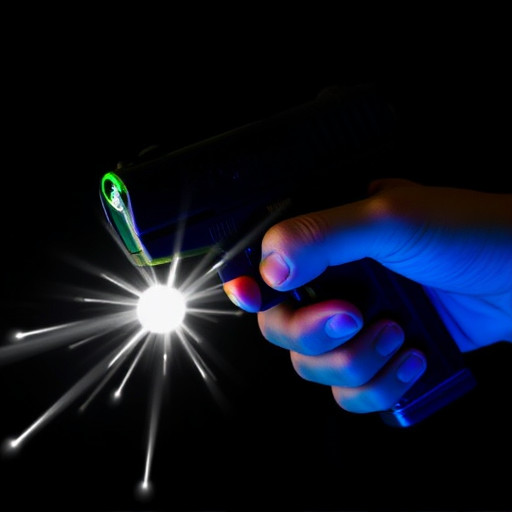Stun guns, or electronic control devices (ECDs), are non-lethal self-defense tools that temporarily incapacitate attackers through high-voltage, low-current electric pulses. These devices disrupt muscle control by delivering intense pain and causing temporary paralysis without permanent harm. Understanding how stun guns work, their components, and safety measures is crucial for effective and responsible use in personal protection, with legality varying by region.
Stun guns, a non-lethal self-defense tool, have gained popularity as personal protection devices. This article delves into the science and mechanics behind stun guns, exploring their effectiveness, design innovations, and safe usage practices. We dissect the key components that make modern stun guns reliable and discuss legal considerations to empower users with knowledge for optimal self-defense. Understanding how stun guns work is crucial for those seeking effective personal protection in today’s uncertain world.
Understanding Stun Guns: A Non-Lethal Self-Defense Tool
Stun guns, also known as electroshock weapons, are non-lethal self-defense tools designed to temporarily incapacitate an attacker through electric current. They work by delivering a strong electrical pulse that disrupts muscle control in the target’s body, causing them to experience intense pain and temporary paralysis. This disruption prevents the muscles responsible for movement from functioning properly, effectively neutralizing the threat without causing permanent harm.
These devices operate on a simple principle: applying a high voltage, low-amperage electrical charge to the body. When activated, the stun gun generates a pulse that travels through conductive paths on the target’s skin and into their nervous system. This electric shock can last for a few seconds, enough time for the user to escape or subdue the assailant. The effectiveness of a stun gun depends on factors like the device’s power output, the length of the probes, and the area of contact with the attacker’s body.
The Science Behind Stun Gun Effectiveness
Stun guns, also known as electronic control devices (ECDs), work by delivering a powerful electrical shock to disrupt an assailant’s neuromuscular system. When activated, the stun gun generates a high-voltage, low-current electric pulse that interrupts the body’s natural electrical signals, causing muscles to contract and lose control momentarily. This disruption can incapacitate an attacker, providing the user with crucial time to escape or defend themselves.
The effectiveness of a stun gun lies in its ability to deliver this shock quickly and efficiently. The device typically consists of two electrodes that make contact with the assailant’s body, allowing the electric current to flow through and cause the desired effect. Modern stun guns use smart technology to optimize pulse width and voltage, ensuring consistent performance in various situations. This scientific approach behind stun guns’ functionality has made them a popular personal protection tool for individuals seeking non-lethal means of self-defense.
Components and Design of Modern Stun Guns
Modern stun guns are designed with several key components that work together to deliver a powerful electric shock for personal protection. At their core, they typically feature two main parts: an electrical circuit and a set of electrodes. The electrical circuit is responsible for generating and controlling the high-voltage, low-current pulse that’s delivered through the electrodes. This pulse disrupts the body’s normal muscle function, causing temporary paralysis or disorientation in the target.
The design often includes a trigger mechanism that allows for precise control over when and how much energy is released. Some models also incorporate safety features like mechanical locks to prevent accidental activation and tactical designs for ease of use in stressful situations. Additionally, stun guns may have various shapes and sizes, from compact devices that can easily fit in one’s hand to larger models meant for enhanced visibility and impact. These variations cater to different user preferences and needs, ensuring individuals can choose a stun gun that suits their personal protection requirements effectively.
Use and Safety Measures for Optimal Protection
When using a stun gun for personal protection, understanding both its functionality and safety measures is paramount. Stun guns, or electronic control devices (ECDs), work by delivering a powerful electric shock through two probes connected to the device. This shock disrupts muscle control in the target, causing them to experience temporary incapacitation. The effect can last from several seconds to a few minutes, providing users with enough time to escape or call for help.
To ensure optimal protection, it’s crucial to follow safety guidelines. Stun guns should only be used as a last resort when facing an imminent threat. Users must also be trained in the device’s operation and familiar with local laws regarding stun gun usage. Regular maintenance and proper storage are essential; keep the device charged and in a secure place to prevent accidental activation. Additionally, practicing target acquisition and understanding the range limitations of the stun gun will enhance its effectiveness as a personal protection tool.
Legal Considerations and Personal Responsibility
When considering a stun gun for personal protection, it’s crucial to understand the legal landscape surrounding their use. The legality of stun guns varies significantly by jurisdiction, with some regions allowing them for self-defense while others have strict regulations or outright prohibit their possession. It’s essential to research and comply with local laws to avoid legal repercussions.
Personal responsibility plays a vital role in deciding to carry a stun gun. Users must understand the device’s operation, safety features, and potential consequences of its use. Responsible handling includes familiarizing oneself with the weapon’s range, durability, and the fact that it is designed to temporarily incapacitate an assailant, not cause permanent harm. This awareness fosters wise decision-making in potentially dangerous situations.
